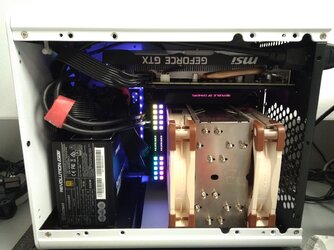- Joined
- Jul 16, 2005
- Location
- Bermuda
Well, I think it's finally time to pull the trigger on a new build. My current system is essentially what's listed in my sig, all packed into a Thermaltake Armor case. I'd like to move to a SFF setup to clear some floor space but I'd like the system to be quiet which I know can be a bit of an upward struggle with a SFF setup. I'm currently looking at the hardware listed below and am trying to decide what to do with the panel configuration on the case. I'm leaning towards a vented panel on the GPU side and a windowed panel on the motherboard side, with all fans blowing as exhaust. This will pull fresh air past the GPU easily keeping it as cool as if it was on an open bench if not cooler due to the inherent airflow. I am somewhat concerned about the motherboard not being cool enough with the window but would like opinions.
Note that I wouldn't mind going with a 32GB RAM kit, but will cut things somewhat close budget-wise. All parts have to be shipped to Bermuda, going through a freight forwarder as it will be far cheaper than any other direct method with the exception of possibly the case. Shipping rates are calculated by the actual or dimensional weight, with the greater being the charge.
There is also duty on items imported. Essentially tack on an additional 26% to the item cost to cover duty and administration fees. I estimate the total for the parts list below will be around $2,900 to $3,100 all said and done. Before I go ahead and pull the trigger I'd like to make sure that there aren't better choices for the hardware selection. What do you guys think?
Freight Forwarder Rates:
Note that I wouldn't mind going with a 32GB RAM kit, but will cut things somewhat close budget-wise. All parts have to be shipped to Bermuda, going through a freight forwarder as it will be far cheaper than any other direct method with the exception of possibly the case. Shipping rates are calculated by the actual or dimensional weight, with the greater being the charge.
There is also duty on items imported. Essentially tack on an additional 26% to the item cost to cover duty and administration fees. I estimate the total for the parts list below will be around $2,900 to $3,100 all said and done. Before I go ahead and pull the trigger I'd like to make sure that there aren't better choices for the hardware selection. What do you guys think?
PCPartPicker Part List:
CPU: AMD Ryzen 7 3700X 3.6 GHz 8-Core Processor ($328.90 @ OutletPC)
CPU Cooler: Corsair H100i PRO 75 CFM Liquid CPU Cooler ($116.98 @ Amazon)
Motherboard: Gigabyte X570 I AORUS PRO WIFI Mini ITX AM4 Motherboard ($219.79 @ SuperBiiz)
Memory: G.Skill Ripjaws V 16 GB (2 x 8 GB) DDR4-3600 Memory ($84.99 @ Newegg)
Storage: Intel 660p Series 2.048 TB M.2-2280 NVME Solid State Drive ($199.89 @ OutletPC)
Storage: Seagate BarraCuda 4 TB 2.5" 5400RPM Internal Hard Drive ($122.00 @ Amazon)
Video Card: Gigabyte Radeon RX 5700 XT 8 GB GAMING OC Video Card ($418.99 @ SuperBiiz)
Power Supply: EVGA SuperNOVA GM 550 W 80+ Gold Certified Fully Modular SFX Power Supply ($89.94 @ ModMyMods)
Case Fan: Noctua NF-A12x25 PWM 60.1 CFM 120 mm Fan ($29.90 @ Amazon)
Case Fan: Noctua NF-A12x25 PWM 60.1 CFM 120 mm Fan ($29.90 @ Amazon)
Case Fan: Noctua NF-A12x25 PWM 60.1 CFM 120 mm Fan ($29.90 @ Amazon)
Case Fan: Noctua NF-A12x25 PWM 60.1 CFM 120 mm Fan ($29.90 @ Amazon)
Keyboard: Logitech G613 Wireless Standard Keyboard ($81.89 @ OutletPC)
Mouse: Logitech G900 CHAOS SPECTRUM Wireless Optical Mouse ($79.50 @ Amazon)
Custom: Sliger SM570 ($259.00)
Total: $2121.47
Prices include shipping, taxes, and discounts when available
Generated by PCPartPicker 2019-10-05 13:29 EDT-0400
CPU: AMD Ryzen 7 3700X 3.6 GHz 8-Core Processor ($328.90 @ OutletPC)
CPU Cooler: Corsair H100i PRO 75 CFM Liquid CPU Cooler ($116.98 @ Amazon)
Motherboard: Gigabyte X570 I AORUS PRO WIFI Mini ITX AM4 Motherboard ($219.79 @ SuperBiiz)
Memory: G.Skill Ripjaws V 16 GB (2 x 8 GB) DDR4-3600 Memory ($84.99 @ Newegg)
Storage: Intel 660p Series 2.048 TB M.2-2280 NVME Solid State Drive ($199.89 @ OutletPC)
Storage: Seagate BarraCuda 4 TB 2.5" 5400RPM Internal Hard Drive ($122.00 @ Amazon)
Video Card: Gigabyte Radeon RX 5700 XT 8 GB GAMING OC Video Card ($418.99 @ SuperBiiz)
Power Supply: EVGA SuperNOVA GM 550 W 80+ Gold Certified Fully Modular SFX Power Supply ($89.94 @ ModMyMods)
Case Fan: Noctua NF-A12x25 PWM 60.1 CFM 120 mm Fan ($29.90 @ Amazon)
Case Fan: Noctua NF-A12x25 PWM 60.1 CFM 120 mm Fan ($29.90 @ Amazon)
Case Fan: Noctua NF-A12x25 PWM 60.1 CFM 120 mm Fan ($29.90 @ Amazon)
Case Fan: Noctua NF-A12x25 PWM 60.1 CFM 120 mm Fan ($29.90 @ Amazon)
Keyboard: Logitech G613 Wireless Standard Keyboard ($81.89 @ OutletPC)
Mouse: Logitech G900 CHAOS SPECTRUM Wireless Optical Mouse ($79.50 @ Amazon)
Custom: Sliger SM570 ($259.00)
Total: $2121.47
Prices include shipping, taxes, and discounts when available
Generated by PCPartPicker 2019-10-05 13:29 EDT-0400
Freight Forwarder Rates:
First pound - $14.75
Each additional pound (from 2 to 30lbs) - $4.40
Each additional pound (from 31 to 150lbs) - $3.20
Dimensional Weight = Package Length x Width x Height divided by 139
Each additional pound (from 2 to 30lbs) - $4.40
Each additional pound (from 31 to 150lbs) - $3.20
Dimensional Weight = Package Length x Width x Height divided by 139
